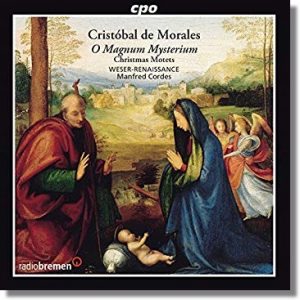In the past four years, our choir has been privileged to sing five different pieces by a sadly neglected composer from the Spanish Renaissance, Cristóbal de Morales (c.1500-1553). Born in Seville, Morales was hailed during his lifetime as “la luz de España en la music” (“the light of Spain in music”). He was clearly the most famous Spanish composer before Tomás Luis de Victoria (c.1548-1611) and probably one of the most widely performed composers throughout Christendom in the middle of the sixteenth century. Between 1535-1545, he sang in the choir of the Sistine Chapel. His time in Rome may have some bearing on the fact that his compositional style seems to have influenced the work of the most famous Italian Renaissance composer (and longtime church musician in Rome), Giovanni Pierluigi da Palestrina (1525-1594). Palestrina wrote a mass based on Morales’s setting of O sacrum convivium (which is one of the Morales motets our choir has sung, most recently at the ordination service for Fr. Mark Perkins in August).
On Christmas Eve 2017, we sang his setting of O magnum mysterium, the text of which makes it one of the most down-to-earth yet mystical of Christmas lyrics. Morales’s version of the text includes a sentence that is unique among dozens (if not hundreds) of others (in bold below):
O great mystery and wondrous sacrament,
that the animals should witness the birth of the Lord in the manger.
Blessed are you, O Virgin Mary, whose womb was deemed worthy to bear Christ the Lord.
Lord, I have heard word of you and was frightened;
I have seen your deeds, and was terrified, in the company of two beasts.
The more famous setting of this text — by Victoria — concludes with a triumphant and celebratory peal of “Alleluias,” as if the angels have already arrived. By contrast, Morales maintains the quiet mystery of the Nativity right to the last chord. Musicologist Christiane Wiesenfeldt has observed that Morales “cultivated an archaically mystical, expressive tonal idiom that one might almost term placeless and timeless.”

O magnum mysterium is the first motet in this album of Christmas-themed music sung by the Weser-Renaissance ensemble, conducted by Manfred Cordes. I say “Christmas-themed,” since there are pieces here associated more precisely with Advent (Veni Domine, et noli tardare, “Come, Lord, and do not delay”), with the Annunciation (Ave Maria), and with the Virgin Mary more generally (Salve regina, “Hail, Queen”). But the miracle of the Incarnation celebrated during Christmas isn’t exclusively or primarily about the Nativity, so such a broad definition of “Christmas motets” can be defended.
The longest piece on this album (which you can hear below) is Cum natus esset Jesus (“When Jesus was born”). It presents the entire text from St. Matthew 2:1-12 — the account of the Magi encountering Herod, then making their way to Bethlehem (home lately of a great mystery involving farm animals). Notice that the middle section of this piece is sung (fittingly) by three male voices.